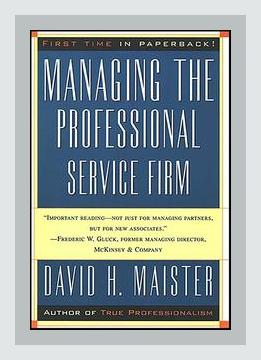Operations and Supply Chain ManagementService Operations
Introduction
“Managing the Professional Service Firm” by David H. Maister is a comprehensive guide specifically tailored to the complexities and unique challenges that firms providing professional services encounter. Unlike product-based businesses, professional service firms (PSFs) deal primarily with human capital, client relationships, and the management of knowledge-intensive services. Maister distills decades of experience into actionable insights for managing PSFs effectively.
I. The Nature of Professional Service Firms
Key Points and Actions:
- Human Capital as the Primary Asset:
- Point: The core asset of any PSF is its human capital – the skill, knowledge, and expertise of its professionals.
-
Action: Invest in ongoing training and development programs to ensure continual skill enhancement.
-
Client-Centric Operations:
- Point: Success hinges on client satisfaction and long-term relationships rather than one-off transactions.
- Action: Implement client feedback loops and develop relationship management practices to foster sustained engagement.
Examples from the Book:
Maister describes how a law firm developed a client advisory panel to regularly solicit feedback, which led to increased client satisfaction and retention.
II. Marketing and Selling Professional Services
Key Points and Actions:
- Building a Reputation:
- Point: Unlike product companies, PSFs thrive on their reputation for expertise and results.
-
Action: Encourage thought leadership through publishing, speaking engagements, and maintaining a visible presence in industry forums.
-
Client Segmentation:
- Point: Not all clients are equal; segment them based on profitability, growth potential, and strategic fit.
- Action: Develop tailored service offerings and dedicate specific teams to high-potential clients to maximize relationship value.
Examples from the Book:
The text shares how a consulting firm segmented clients and dedicated resources to the top 20% of its clientele, driving substantial growth through bespoke service delivery.
III. Managing Client Relationships
Key Points and Actions:
- Understanding Client Needs:
- Point: It’s crucial to move beyond transactional relationships to truly understand the client’s broader business context.
-
Action: Conduct comprehensive client workshops to identify underlying business challenges and opportunities.
-
Adding Value:
- Point: PSFs must consistently find ways to add value beyond the initial service offering.
- Action: Develop case studies and find synergies within the firm’s capabilities to offer bundled services.
Examples from the Book:
Maister illustrates how a financial advisory firm redefined its offering by integrating tax advisory, leading to additional client value and higher service uptake.
IV. Managing the Service Portfolio
Key Points and Actions:
- Diversification of Services:
- Point: Diversifying services can mitigate risk and stabilize revenue across various economic cycles.
-
Action: Regularly assess market trends and client needs to identify opportunities for new service offerings.
-
Service Delivery Innovation:
- Point: Continuous improvement in service delivery processes can lead to better efficiency and client satisfaction.
- Action: Employ Six Sigma methodologies or similar process improvement frameworks to refine service execution.
Examples from the Book:
Using the example of an engineering firm, Maister illustrates how the adoption of lean methodologies enhanced project delivery speed and reduced costs, delighting clients.
V. Organizational Structure and Leadership
Key Points and Actions:
- Decentralized Decision-Making:
- Point: Empowering lower-tier managers with decision-making authority can lead to faster responses and innovation.
-
Action: Implement a decentralized governance model to distribute decision-making power appropriately across the firm.
-
Leadership Development:
- Point: Effective leadership at all levels is essential for the success of PSFs.
- Action: Invest in leadership development programs and mentoring systems to groom the next generation of leaders.
Examples from the Book:
Maister mentions an architecture firm that created a series of internal leadership workshops, resulting in a more resilient and dynamic organizational structure.
VI. Financial Management
Key Points and Actions:
- Billing and Pricing Strategies:
- Point: Effective pricing strategies that reflect the value delivered are crucial.
-
Action: Shift from hourly billing to value-based pricing models where feasible, ensuring alignment with client-perceived value.
-
Cost Control:
- Point: Managing costs without compromising service quality is critical.
- Action: Establish rigorous budgeting processes and financial monitoring systems to control operational expenses.
Examples from the Book:
The book describes a management consulting firm that moved to a fixed-fee structure, which increased client trust and predictability in revenue streams.
VII. Managing Professional Teams
Key Points and Actions:
- Recruitment and Retention:
- Point: Attracting and retaining top talent is a perpetual challenge for PSFs.
-
Action: Develop a strong employer brand and use competitive compensation packages, alongside flexible work arrangements, to attract and retain talent.
-
Team Development:
- Point: Continual professional development and fostering a collaborative culture are essential.
- Action: Facilitate regular professional development programs and create avenues for teamwork and knowledge sharing.
Examples from the Book:
Maister refers to a healthcare consulting firm that instituted a mentorship program and saw a marked improvement in both employee satisfaction and client service quality.
VIII. Strategic Planning and Adaptation
Key Points and Actions:
- Anticipating Market Changes:
- Point: Being proactive rather than reactive to market changes can provide a competitive edge.
-
Action: Conduct regular SWOT analysis and scenario planning sessions to anticipate and prepare for market shifts.
-
Innovation Culture:
- Point: Cultivating an organizational culture that embraces innovation is vital.
- Action: Create an internal innovation lab or think-tank to explore new service offerings and business models.
Examples from the Book:
A case study showcases a law firm that established a tech innovation hub to develop legal technology solutions, resulting in new revenue streams and service differentiation.
Conclusion
In “Managing the Professional Service Firm,” David Maister provides a detailed roadmap for navigating the unique challenges faced by PSFs. By focusing on human capital, defining rigorous marketing strategies, fostering client relationships, diversifying services, empowering leadership, managing finances effectively, nurturing professional teams, and being strategic in planning, firms can achieve sustainable growth and success. The actionable insights and real-world examples present in the book serve as invaluable tools for anyone involved in the management of a professional service firm.
